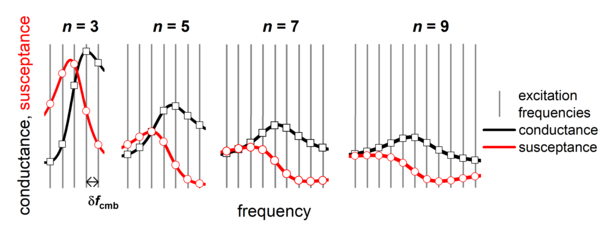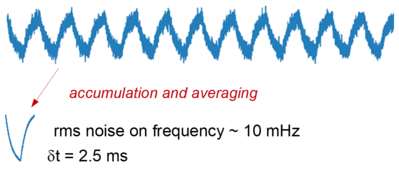
Traditional QCM struggles with two problems. Firstly, the time resolution with values in the range of > 100 ms leaves something to be desired. The competing optical techniques far outperform QCM in this respect. Another problem is a drift of the resonant frequency in the order of 1 Hz/h, which is due to the migration of defects and can hardly be avoided in practice.
The modulation QCM represents progress in both respects. The modulation QCM initially uses multifrequency lockin amplification for improved time resolution (< 5 ms in liquids). The improved time resolution is independent of the modulation and is still accompanied by a loss of accuracy (as is always the case with fast measurements). The trade-offs are admitted: One can use QCM to measure processes that occur on the millisecond time scale[1,2].

The measurement accuracy can be improved for periodic processes by means of accumulation and averaging. Such periodic processes are, for example, modulation experiments. Modulation requires a stimulus and a response. A stimulus could be a changing DC potential at the front electrode of the resonator.[3,4] The response would then be a slightly changed resonant frequency, which could occur, for example, because the diffuse double layer of an electrolyte solution is recharged. If the stimulus is now applied periodically (e.g. with a clock rate of 1/s) and the response accumulates overnight, the frequency resolution is proportional to N1/2 with N the number of cycles (definitely N > 1000).The frequency resolution can then be a few mHz. 5 mHz correspond (for 5-MHz resonators and at a density of 1 g/cm3) to a change in layer thickness of 1 pm. The QCM is then sensitive to less than 1% of a monolayer.Again, this requires stimulus-response experiments and overnight accumulation. The high time resolution is maintained. Of course, the resonant frequency drifts, but this has little effect on this form of measurement because it is accumulated over the cycles. The drift during a single cycle is insignificant.
The most obvious applications of modulation QCM are in electrochemistry.
Literature
- Leppin, C.; Hampel, S.; Meyer, F. S.; Langhoff, A.; Fittschen, U. E. A.; Johannsmann, D.
A Quartz Crystal Microbalance, Which Tracks Four Overtones in Parallel with a Time Resolution of 10 Milliseconds: Application to Inkjet Printing.
Sensors 2020, 20, 5915. - Wiegmann, J.; Leppin, C.; Langhoff, A.; Schwaderer, J.; Beuermann, S.; Johannsmann, D.; Weber, A. P.
Influence of the Solvent Evaporation Rate on the beta-Phase Content of Electrosprayed PVDF Particles and Films Studied by a Fast Multi-Overtone QCM.
Advanced Powder Technology 2022, 33, (3), 103452. - Leppin, C.; Langhoff, A.; Johannsmann, D.
Square Wave Electrogravimetry Combined with Voltammetry Reveals Reversible Submonolayer Adsorption of Redox-Active Ions.
Analytical Chemistry 2022. - Leppin, C.; Langhoff, A.; Höfft, O.; Johannsmann, D.
A Modulation QCM Applied to Copper Electrodeposition and Stripping.
Electroanalysis 2021.